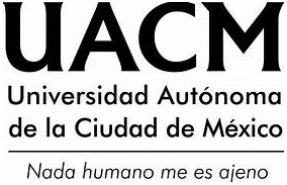Mario Molina and the saga of ozone example of linking science and society
DOI:
https://doi.org/10.29092/uacm.v12i29.17Keywords:
Science-society, ozone layer, infrastructure, leadership, flexibilityAbstract
We present an analysis between research article published in 1974 which alerted the world about the loss of the ozone layer and in parallel on one of its authors, Mario Molina. We review how the study came about and which were its societal consequences out of the academic scientific ambit. Through this particular point of view we characterize the relationship science-society around three lines of analysis: infrastructure, leadership and flexibility. We use this characterization to ponder opportunities for Latin America like interaction between government, academy and industry, the investment in science and technology and long term projects.
Downloads
References
Andersen, S. O. y M. K. Sarma (2002), Protecting the Ozone Layer: the United Nations History. Londres: Earthscan Press.
Chubachi, S. (1984), “Preliminary Result of Ozone Observations at Syoma Station from February 1982 to January 1983”, en Memoirs of National Institute of Polar Research, Special Issue, no. 34, Tokio: National Institute of Polar Research, pp. 13-20.
Cicerone, R. J. et al. (1973), Assessment of Possible Environmental Effects of Space Shuttle Operations. Huntsville: nasa.
CMM (2015), Texto en línea disponible en: http://centromariomolina.org/ (consulta: 20 de enero de 2015).
Diamond, S. J. (1976), “Why Ban Aerosol Sprays? A Noted Chemist Tells How They Endanger the Ozone and Us”, en People Weekly, vol. 6. no. 16, octubre, Tampa: People Magazine, pp. 45-51.
Douglas, A. R., P. A. Newman, y S. Solomon (2014), “The Antartic Ozone Hole: an Update”, en Physics Today, vol. 67, no. 7, Melville: American Institute of Physics, pp. 42-48.
EPA(1999), The Benefits and Costs of the Clean Air Act 1990 to 2010: EPA Report to Congress. Washington: United States Environmental Protection Agency.
Farman, J. C. et al. (1985), “Large Losses of Total Ozone in Antarctica Reveal Seasonal Clox/NOx Interaction”, en Nature, vol. 315, no. 6016, Londres: Macmillan Magazines, pp. 207-210.
Lambright, W. H. (2005), The Case of Ozone Deplation. Washington: NASA.
Molina, M. J. y F. S. Rowland (1974), “Stratospheric Sink for Chlorofluoromethanes —Chlorine Atomic— Catalysed Destruction of Ozone”, en Nature, vol. 249, no. 5460, Londres: Macmillan Magazines, pp. 810-812.
____(2000), The cfc-Ozone Puzzle: Environmental Science in the Global Arena. Washington: National Council for Science and the Environment.
Molina, M. J. (2014), “Mario J. Molina – Biographical”, Texto en línea disponible en: <http://www.nobelprize.org/nobel_prizes/chemistry/laureates/1995/moli na-bio.html> (consulta: 13 de noviembre de2014).
UNEP (1987), Montreal Protocol on Substances That Deplete the Ozone Layer. Nairobi: United Nations Environment Programme.
NAS (1976), Halocarbons: Effects on stratospheric ozone. Washington: National Academy of Science.
Oreskes, N. y E. Conway (2010), Merchants of Doubt. New York: Bloomsbury Press.
Reagan, R. (1988), “Statement on Signing the Montreal Protocol on Ozone-Depleting Substances”, Artículo disponible en: <http://www.presidency.ucsb.edu/ws/?pid=35639> (consulta: 14 de noviembre de 2014).
Rowland, F. S. y M. J. Molina, (1975), “Ozone Question”, en Science, vol. 190, no. 4219, Nueva York: American Association for the Advancement of Science, pp. 1038-1039.
Rowland, F. S. (1996), “Nobel Lecture in Chemistry”, en B. G. Malmström (editor), Nobel Lectures, Chemistry 1991-1995. Singapur: World Scientific Publishing Co., pp. 280-370.
Slaper H. et al. (1996), “Estimates of Ozone Depletion and Skin Cancer Incidence to Examine the Vienna Convention Achievements”, en Nature, vol. 384, no. 6606, Londres: Macmillan Magazines,
pp. 256-258.
Sunstein, C. R. (2007), “Of Montreal and Kyoto: A Tale of Two Protocols”, en Harvard Environmental Law Review, vol. 31, num. 1, Cambridge: Harvard Law School, pp. 1-65.
UNEP (1998), Environmental Effects of Ozone Depletion: 1998 Assessment. Nairobi: United Nations Environment Program.
WHO (1994), The Effects of Solar Radiation on the Eye. Ginebra: World Health Organization Programme for the Prevention of Blindness.
WMO (2014), Assessment for Decision-Makers: Scientific Assessment of OzoneDepletion: 2014. Ginebra: World Meteorological Organization.
Published
Issue
Section
License
This Journal is licensed under Creative Commons Mexico 2.5. It is allowed to reproduce and disseminate the contents of the Journal for educational or research purposes, not for profit, as long as they are not mutilated and cite the source (Andamios, Revista de Investigación Social) and the author.
The copyright of the articles published in Andamios, Revista de Investigación Social are transferred by the author(s) to Universidad Autónoma de la Ciudad de México when the originals have been accepted, so that they are published and distributed both in the printed and electronic versions of the Journal. However, as established by law, the author(s) retains their moral rights. The author(s) will receive a form of assignment of copyright that they must to sign when their original has been accepted. In the case of collective articles, the signature of one of the authors will suffice, provided that the latter has obtained the consent of the others.
Authors may use the material of their article in other works or books published by themselves, with the condition of quoting Andamios as the original source of the texts.
The articles contained in this publication are the responsibility of their authors and do not compromise the official position of Andamios, Revista de Investigación Social of the Universidad Autónoma de la Ciudad de México.


